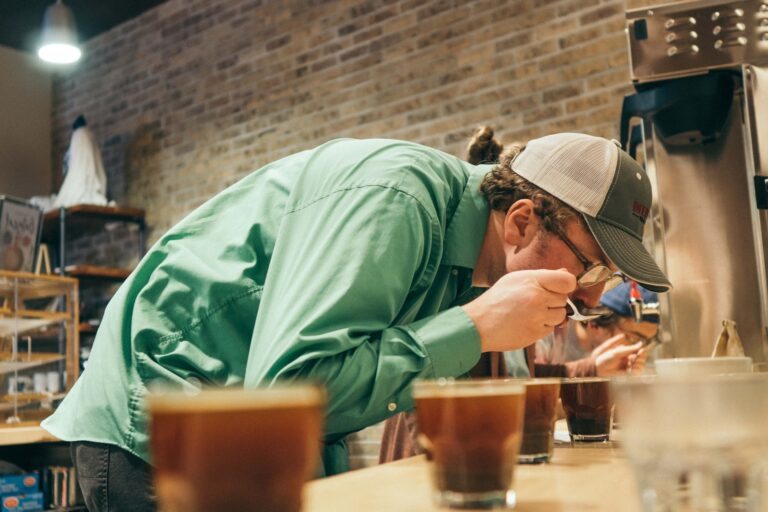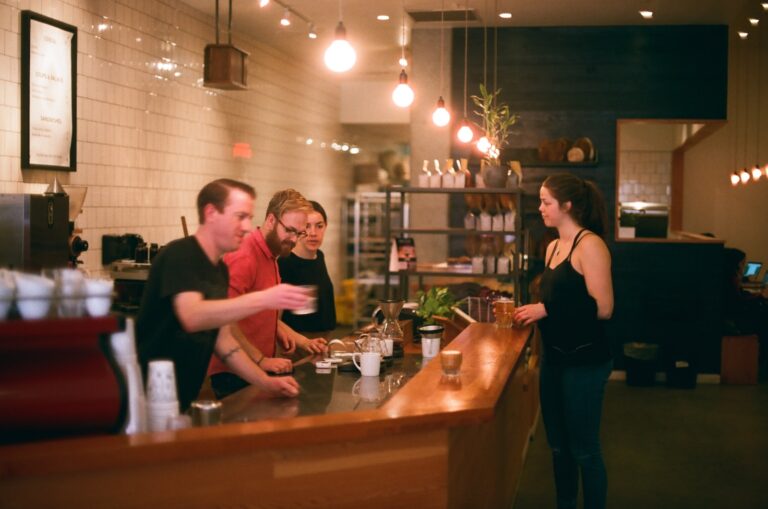Coffee has long been synonymous with creativity, serving as a steadfast companion through sleepless nights and fueling imaginative minds. From the picturesque cafes of Paris to the bustling streets of New York City, coffee has tirelessly poured its way into literature and film, leaving an indelible mark on our cultural landscape.
Join us as we delve deep into the caffeinated world where espresso shots meet typewriters, where dark roast inspires dark tales, and where every sip brings us closer to unraveling the captivating influence of coffee on literature and film. So grab a steaming cup of your favorite brew and get ready for a journey through caffeine-fueled inspiration like never before!
Introduction: How coffee has become a staple in our daily lives and its impact on literature and film.

Coffee is a beloved beverage that has become an integral part of our daily lives. Its rich aroma, bold taste, and magical ability to perk us up have made it a staple in many cultures around the world. From being just a simple drink, coffee has evolved into a symbol of comfort, productivity, and sometimes even rebellion.
But beyond its role as a popular beverage, coffee has also left its mark on literature and film. Throughout history, this humble bean has been mentioned, celebrated, and even vilified in various works of art. In this section, we will explore how coffee has influenced literature and film and how these mediums have reflected our ever-evolving relationship with this captivating drink.
Coffee in Literature
Coffee has been deeply intertwined with literature for centuries, serving as not only a popular beverage but also a powerful symbol in many literary works. Throughout history, writers have used coffee both literally and metaphorically to convey various themes and ideas in their works, making it an integral part of the literary world.
The origins of coffee as a literary motif can be traced back to the 16th century, when the drink first gained popularity in Europe. With its introduction to Western society, coffee quickly became associated with intellectualism and creativity due to its stimulating effects on the mind.
This perception was further reinforced by the emergence of coffeehouses as gathering places for artists, philosophers, and other writers to exchange ideas and engage in lively discussions. As such, it is no surprise that many pieces of literature from this period feature references to coffee or take place in these bustling cafes.
Coffee as a symbol in works of fiction
Coffee has been a popular beverage in many cultures around the world for centuries, and its widespread consumption has led to it being incorporated into various aspects of our daily lives. One such aspect is literature and film, where coffee has been portrayed as more than just a simple drink. It has been used symbolically in works of fiction to represent a variety of themes and ideas.
One of the most prominent symbols associated with coffee is its ability to bring people together. In many works of fiction, coffee is used as a tool for fostering relationships and connections between characters. For instance, in J.D Salinger’s novel “Franny and Zooey,” the main character Franny finds solace in drinking coffee with her brother Zooey amidst her existential crisis. The warmth and comfort provided by the act of sharing a cup of coffee creates an atmosphere conducive to open and intimate conversations.
In addition to this, coffee is also often depicted as a symbol of energy and productivity. In film adaptations such as “The Devil Wears Prada” or “Wall Street: Money Never Sleeps,” characters are seen constantly sipping on cups of coffee while working tirelessly towards their goals. This association with caffeine can be traced back to its origins as a stimulant that helps keep people alert and focused, making it an ideal symbol for hard work and determination.
The role of coffee shops as gathering places for writers and intellectuals
Coffee shops have a long history of being gathering places for writers and intellectuals. From the bustling cafes of Paris in the 1920s to the cozy coffee houses of modern-day cities, these establishments have provided a space for creatives to meet, socialize, and draw inspiration from each other.
One possible reason for this is the stimulatory effect of caffeine on the brain. As writers and intellectuals often engage in mentally demanding work, a cup of coffee can provide that extra burst of energy and focus needed to sustain their creativity and critical thinking skills. In fact, a study from the University of Arkansas found that moderate amounts of caffeine can improve cognitive performance and creative problem-solving abilities.
Moreover, coffee shops offer an environment conducive to intellectual discussions. With its laid-back atmosphere and warm ambiance, they provide a relaxed yet stimulating setting for individuals to engage in deep conversations about literature, philosophy, politics, and more. The presence of like-minded individuals also creates a sense of community among writers and thinkers who may otherwise feel isolated working alone.
Additionally, coffee shops serve as hubs for networking opportunities within the writing community. Writers often seek feedback or advice from fellow writers at these establishments or attend open mic nights where they can share their own work with others. This fosters collaboration and promotes growth within the literary world.
Famous authors who were avid coffee drinkers
Coffee has long been known as a beloved beverage for many individuals, providing a boost of energy and enhancing brain function. But did you know that some of the most renowned and influential authors throughout history were also avid coffee drinkers? In this section, we will take a closer look at some of the famous authors who found inspiration in their daily cup (or cups) of coffee.
1] Honore de Balzac
French novelist and playwright, Honore de Balzac is said to have consumed up to 50 cups of coffee per day while working on his literary masterpieces. He believed that drinking large quantities of strong coffee allowed him to stay awake and focus for extended periods of time, enabling him to write for hours on end. This excessive caffeine consumption may have contributed to his infamous insomnia but it also fueled his creativity and productivity.
2] Honoré de Balzac
German writer Johann Wolfgang von Goethe was not only an advocate for coffee but was also instrumental in popularizing its consumption in Europe. He praised the effects of caffeine on mental alertness and productivity, stating that “a cup of coffee clears away all the cobwebs from my brain”. Goethe’s fondness for coffee can be seen in his works such as “Faust”, where he portrays characters enjoying the drink.
3] Fyodor Dostoevsky
Russian author Fyodor Dostoevsky was another famous writer who turned to coffee as a source of inspiration. In fact, he loved it so much that he would often carry a thermos with him to ensure he always had his fix. In his novel, “Notes from Underground”, the protagonist proclaims that “not a single thought congealed in my brain without first being whipped up to life and light by some cup of coffee.” Dostoevsky’s love for coffee can also be seen in his numerous references to the beverage in his other works.
4] Beatrix Potter
Beatrix Potter, best known for her beloved children’s books such as “The Tale of Peter Rabbit”, was known to be an avid coffee drinker. In fact, she even carried her own coffee pot and cups on her countryside walks and would often stop to have a sip while drawing inspiration from her surroundings for her stories.
5] Voltaire
French writer and philosopher Voltaire famously stated, “Coffee is the beverage of the intelligent and active man”. He was known for drinking multiple cups of coffee throughout the day, believing it aided in clearing his thoughts and sharpening his wit. His love for coffee can also be seen in his writing, with references to the drink appearing in many of his works.
Coffee in Film
Coffee has been a staple element in human history, and this extends to the world of film. For decades, filmmakers have utilized coffee as a symbol, prop, and even as a plot device to tell powerful stories and convey complex character traits. From iconic coffee shop scenes to characters who are never seen without their cup of java in hand, coffee has played a significant role in some of the most beloved films of all time.
One way that coffee is often depicted on screen is through its portrayal as a social lubricant. Coffee shops have become popular meeting places for friends and lovers alike in films such as “When Harry Met Sally” and “It’s Complicated”. These scenes not only showcase the power of caffeine to bring people together but also highlight how it can serve as a backdrop for important conversations and key moments in relationships.
In addition to being used as a means for connection, coffee is also frequently used to depict internal struggles or character development on screen. Often, characters will be shown drinking multiple cups of coffee when they are under stress or trying to make important decisions. This can be seen in films like “Fight Club”, where Tyler Durden constantly offers protagonist Jack black cups of overly strong espresso throughout the movie – further emphasizing Jack’s inner turmoil.
The use of coffee as a plot device in movies
The use of coffee as a plot device in movies is a common occurrence that has been prevalent in the film industry for decades. This popular beverage has found its way into various storylines, serving not only as a prop but also as a metaphor for larger themes and messages.
Coffee’s presence in literature and film dates back to the early 1900s with the emergence of American romantic comedies. These films often depicted characters meeting or parting over a cup of coffee, using it as a tool to signify romance or friendship between individuals. From there, coffee became an integral part of storytelling, playing significant roles in shaping character development and driving plot points.
One example of this can be seen in the iconic scene from “Casablanca” where Humphrey Bogart’s character Rick sits down to have coffee with Ingrid Bergman’s Ilsa, sparking one of the most memorable movie quotes: “Here’s looking at you, kid.” The simple act of sharing a coffee served to further strengthen their love story and added depth to their relationship.
Conclusion
In conclusion, coffee has had a significant influence on literature and film, shaping the way we perceive certain characters and settings. From providing a sense of comfort to fueling creativity, coffee has proven to be an integral part of human expression.
Whether it is used as a symbol or simply enjoyed by the characters themselves, this beloved beverage continues to inspire and captivate audiences around the world. So next time you sit down with your favorite book or watch a film noir, remember the impact that coffee has had on these mediums.







